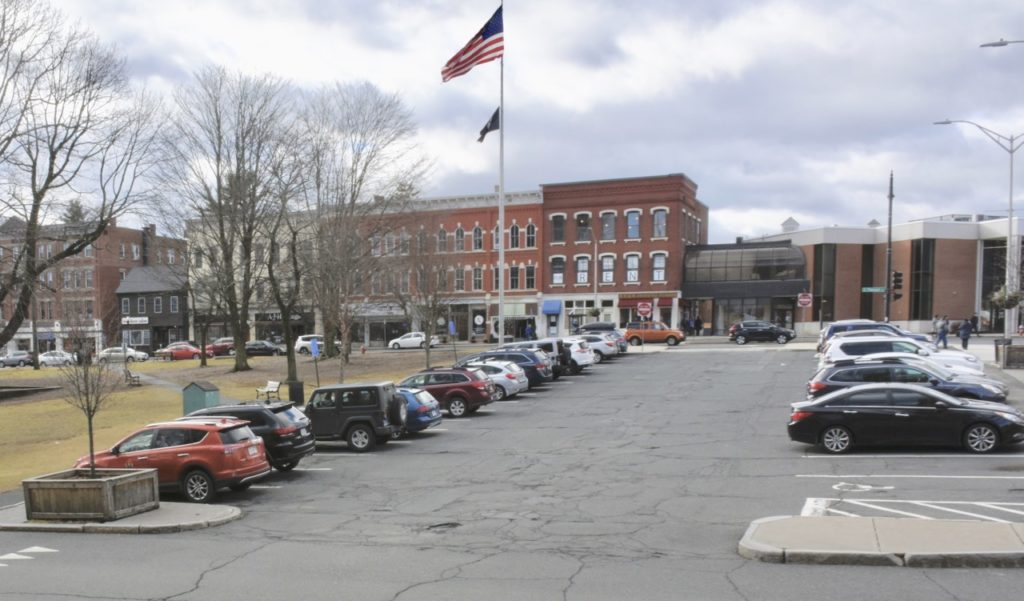AMHERST PARKING IS OK, KNOWING WHERE TO FIND IT IS THE PROBLEM

Amherst North Common parking lot. Photo: Art Keene.
It’s a matter of perception, the matter of parking in Amherst: in reality it isn’t difficult, in perception it is. As it turns out, the only time that even as much as 86 percent of available public parking downtown is utilized is on Saturday nights at 7 p.m.
Two studies have found that available parking in Amherst is underutilized, with about 900 downtown spaces going empty at any given time (except Saturday nights at 7 p.m.). Perhaps the erroneous perception is caused by an expectation that there will be a lot of choices of empty parking spots in front of every store or business, as in a suburban mall, although the entire downtown can be walked in a matter of five or ten minutes.
What should be done to help residents and visitors avail themselves of those 900 or so empty parking spots? In late August, Nelson/Nygaard Consulting Associates suggested a series of goals and strategies, based on the findings of both studies of parking here. Planners Matt Smith and Jason Novsam presented eight overarching goals and strategies to achieve them. The goals are general, such as establishing convenient and accessible parking for everyone living, working, or visiting the center of Amherst. The strategies were more specific. None of them call for a new parking facility. All of them are commonsense and relatively inexpensive.
One of the biggest perceptual problems to address, they said, is caused by a simple lack of signage directing people to parking places. For example, few residents understand that “permit-only” spaces are open and available to anyone every day after 5 p.m. and 24/7 for all of June, July, and August.
Thus, among the strategies that Smith and Novsam recommend is a communications program that includes consistent, readable, straightforward signage that can be seen (and read) from the road. Other recommendations, many of which are being used successfully in other college towns, include:
* establish a Parking Benefit District to support relevant technology and improvements, e.g. license-plate readers, and to routinely track and analyze utilization of downtown parking.
* explore innovative approaches other towns are successfully using, such as free 15-minute parking for quick stops, free parking for people attending government meetings and public forums, first-time forgiveness for newcomers, an eight-minute post-expiration grace period, shared parking that uses private spaces (which are often empty except during business hours and religious services), and tracking available parking through parking apps such as ParkMobile.
* make better use of permit parking, e.g. educate employers and employees about the advantages of using town center permits instead of feeding the meters every few hours, regulate usage.
* establish a parking validation program for stores, restaurants, medical, therapeutic, and legal offices.
* emphasize that people come to Amherst because of the environment here, which precludes large parking facilities like those at shopping malls.
* explore shared valet programs which allow for highly efficient parking.
* improve lighting, accessibility, and maintenance of parking spots, including cutting brush that interferes with parking, sidewalks, crosswalks.
* restripe parking spots from 22 feet each to 20 feet each.
* install additional kiosks and mobile phone apps.
* revise Zoning Bylaws to take into account the increased population caused by new apartment buildings.
* implement “Access Management Requirements (AMRs),” such as bicycle stations.
* require developers to pay extra fees if they do not include adequate parking for their units in their design.
* limit the number of permits available per residential unit.
These and other strategies are planned to be discussed at the September 23 Town Council meeting.

Excellent report on the report, Kitty! Yet it’s surprising that there’s little-to-no mention of a major contributing factor to Amherst’s parking problem: the vast number of cars brought to campus by the approximately 30,000 students, and their increased use during the academic year; this could be alleviated by improving long-distance regional transit between Amherst and the “sending communities” for most of these students (the Boston and New York metropolitan area), as well as our local transit and alternative transit (think: better and more extensive bike-lanes, e.g.) infrastructure. Once we had to point to European cities as a model, but even New York and Philadelphia are now making such improvements – why not Amherst too? Rob Kusner